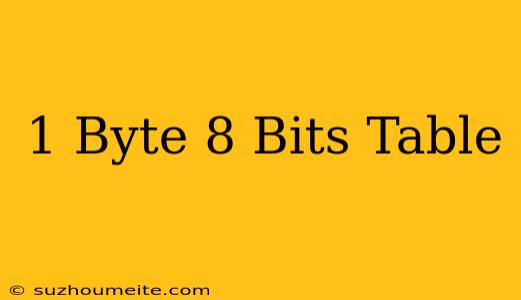1 Byte = 8 Bits: Understanding the Basics of Digital Data
In the world of digital technology, data is represented in the form of bits and bytes. But what exactly is a byte, and how is it related to bits? In this article, we'll explore the concept of 1 byte equaling 8 bits and why it's essential for digital communication.
What is a Bit?
A bit (short for binary digit) is the basic unit of information in computing and digital communications. It represents a single binary value that can have only two distinct values: 0 (zero) or 1 (one). Bits are used to represent information, such as text, images, and audio, in a computer's memory or storage devices.
What is a Byte?
A byte is a group of bits that are used together to represent a single character, number, or other type of data. In most computer systems, a byte consists of 8 bits, which can represent a total of 256 (2^8) unique values.
1 Byte = 8 Bits: Why is this Important?
The reason why 1 byte equals 8 bits is due to the way computers process information. In the early days of computing, the 8-bit byte was adopted as a standard because it provided a good balance between the amount of information that could be stored and the complexity of the computer's circuitry.
The 8-bit byte has several advantages:
- Addressing: With 8 bits, a computer can address a maximum of 256 (2^8) unique locations in memory, which was sufficient for early computer systems.
- Character Representation: The 8-bit byte can represent 256 unique characters, which is enough to represent the alphabet, numbers, and some special characters.
- Binary Math: The 8-bit byte allows for efficient binary arithmetic operations, such as addition and multiplication, which are essential for computer calculations.
Table: Bit Patterns for 1 Byte
Here is a table illustrating the bit patterns for a single byte:
| Bit Pattern | Hex Value | Decimal Value |
|---|---|---|
| 00000000 | 00 | 0 |
| 00000001 | 01 | 1 |
| 00000010 | 02 | 2 |
| ... | ... | ... |
| 11111110 | FE | 254 |
| 11111111 | FF | 255 |
In this table, each row represents a unique bit pattern, its corresponding hexadecimal value, and decimal value. The table demonstrates how a single byte can represent 256 unique values, ranging from 0 to 255.
Conclusion
In conclusion, the concept of 1 byte equaling 8 bits is fundamental to digital technology. It provides a standardized way of representing information in computers and has been adopted universally in digital communication systems. Understanding the relationship between bits and bytes is essential for anyone working with digital technology, from programmers to network administrators.
